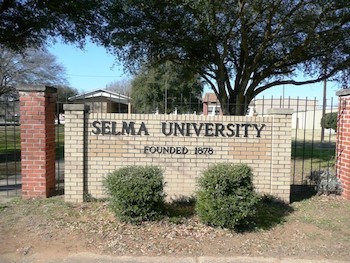Selma University
March 26, 2024 2024-03-26 19:13Selma University
Selma university
Setting a Viable
Future Direction
Developing a strategic plan utilizing staff, faculty, and administrative personnel which will establish a course of conduct and action designed to address student growth, as well as faculty and program enhancement and will provide faculty development training for existing faculty, staff and administrative staff.


- Clear Direction and Vision: It provides a clear sense of direction for the university, outlining its vision, mission, and core values. This clarity helps in decision-making and aligning all activities with the university’s overarching goals.
- Goal Setting: Universities can set specific, measurable, achievable, relevant, and time-bound (SMART) goals. This ensures that efforts are concentrated on achieving tangible outcomes.
- Resource Allocation: Strategic planning helps in allocating resources, including finances, personnel, and facilities, in a way that supports the institution’s priorities. It ensures that resources are used efficiently and effectively.
- Improving Student Outcomes: By identifying specific educational objectives and strategies, universities can enhance the quality of education and student learning outcomes.
- Adaptation to Changing Needs: As the educational landscape evolves, strategic planning allows universities to adapt and stay relevant. They can respond to changes in demographics, technological advancements, and industry demands.
- Enhanced Reputation: A well-executed strategic plan can improve a university’s reputation. It can attract high-quality faculty and students, as well as increase support from donors and stakeholders.
- Innovation and Research: It encourages a culture of innovation and research by defining research priorities, encouraging interdisciplinary collaborations, and securing funding for cutting-edge projects.
- Risk Management: By identifying potential risks and challenges, universities can develop strategies to mitigate them. This proactive approach minimizes the impact of unforeseen events.
- Data-Driven Decision-Making: Strategic planning often involves gathering and analyzing data, which allows universities to make informed decisions based on evidence rather than intuition.
- Engagement and Collaboration: It fosters collaboration and engagement within the university community. Faculty, staff, students, and other stakeholders are more likely to be motivated and involved when they see their input is considered in the planning process.



Compliance and Accreditation: Many accrediting bodies require universities to have a strategic plan. Compliance with accreditation standards is essential for maintaining the institution’s reputation and eligibility for federal funding.
Long-Term Sustainability: It helps ensure the long-term sustainability of the institution by focusing on its financial health, infrastructure, and capacity to serve future generations of students.
In summary, strategic planning is a valuable tool for universities to set and achieve their goals, adapt to changing circumstances, enhance educational quality, and manage resources effectively. It enables universities to remain competitive and meet the needs of their stakeholders in an evolving educational landscape.
This description has critical significance for Selma University, an old established Alabama HBCU. Aiding an Alabama HBCU with sustainability is a core piece of the Alabama HBCU Consortium core mission, which is why the Consortium has committed funds to provide Selma University the ability to employ a recognized strategic plan expert consultant. The consultant will help President Dr. Stanford E. Angion, the faculty and staff to curate their current strategic plan into an updated vision of sustainability for the University.
Hypothetically, if Selma University were to face collapse, it would be the second catastrophic educational loss for the Selma community. Concordia College Alabama was a Private historically black college associated with the Lutheran Church–Missouri Synod and located in Selma, Alabama. It was the only historically black college among the ten colleges and universities in the Concordia University System. Concordia was founded — as the Alabama Lutheran Academy — in Selma in 1922. Rosa J. Young, known as “the mother of black Lutheranism in America,” started the college.
It’s important for those who cherish our Alabama HBCUs to understand what can happen when an institution like Selma University closes or leaves a community.
Economic Impact: Closing Selma University will result in the loss of jobs for faculty, staff, and supporting businesses. Selma University contributes to the local economy by employing local residents and attracting students who spend money in the community.
Educational Opportunities: Closing Selma University will eliminate educational opportunities for local and incoming students. It will limit access to higher education, forcing students to travel farther distances to pursue their degrees, or to rely strictly upon online education outlets, potentially reducing the number of individuals pursuing higher education overall.
Community Identity: Selma University without question is an integral part of the community’s identity. Their presence has influenced the city’s culture, social events, and engagement. Losing Selma University will impact the city’s sense of pride and history and the regional faith-based community with the loss of a leadership pipeline.
Property Values and Real Estate: The closing of Selma University will impact the local real estate market. Properties previously rented or utilized by faculty and students might face decreased demand, affecting property values and rental prices.
Intellectual and Cultural Contributions: There’s no doubt the Selma University continues to contribute to the intellectual and cultural vibrancy of Selma. The University host events, lectures, art exhibitions, and other activities that enrich the community’s cultural landscape. Losing such contributions could leave a cultural void in the city.
Long-Term Development: Selma University must continue to play a role in fostering research, innovation, and development in the city and the region. The absence of this particular educational institution might slow down or hinder potential advancements and collaborations in various fields.
Please note that these impacts are speculative and can vary based on the specific circumstances, size, and influence of Selma University within the city of Selma, Alabama and the regional “Black Belt.” This is why the Consortium is attempting to influence and mitigate as many factors as possible in order to help Selma University stave off closing due to an adverse financial outlook. It’s important to keep in the forefront the impact of Selma University upon the state and the community, including the institution’s history, community ties, and the efforts made to mitigate the effects of closure on the city and its residents.

